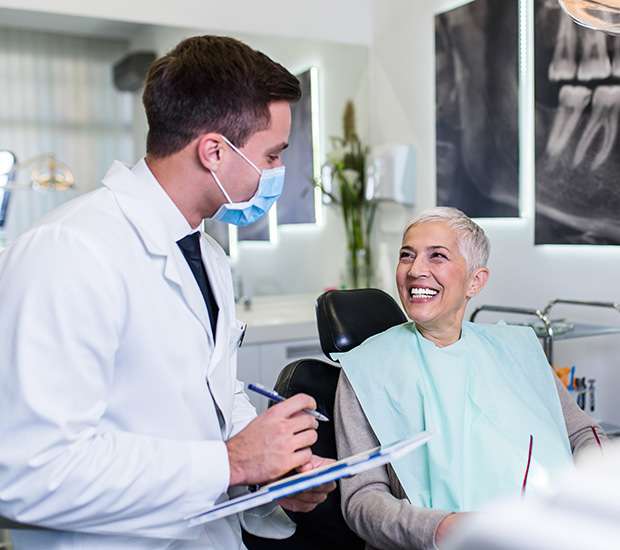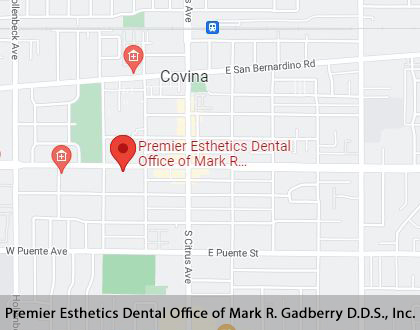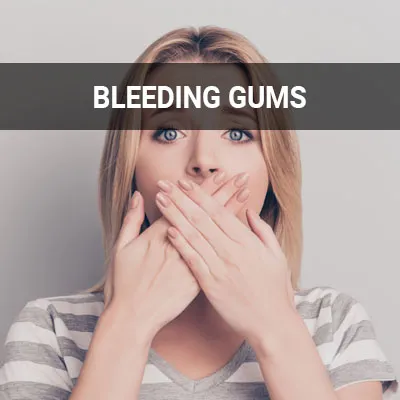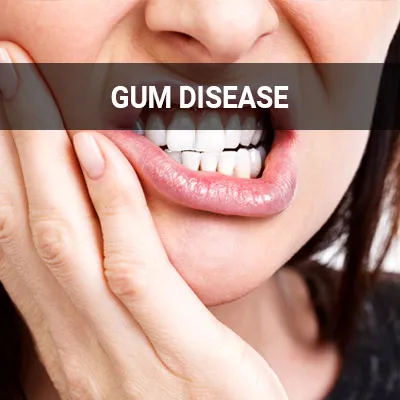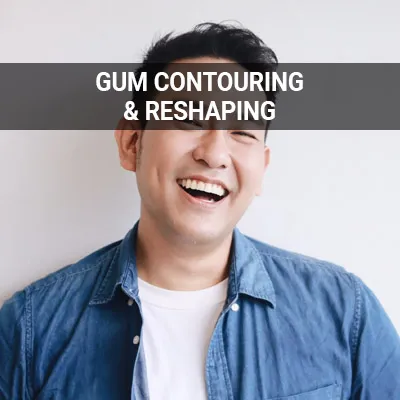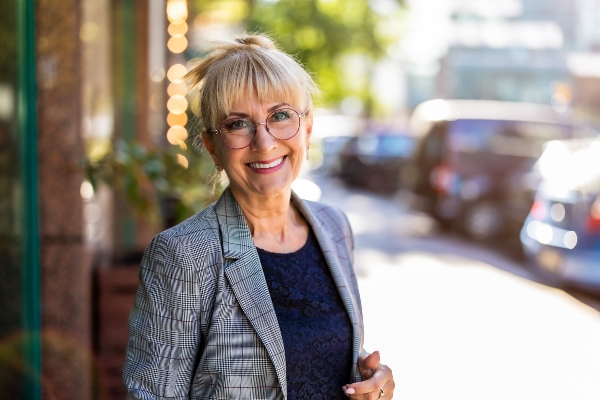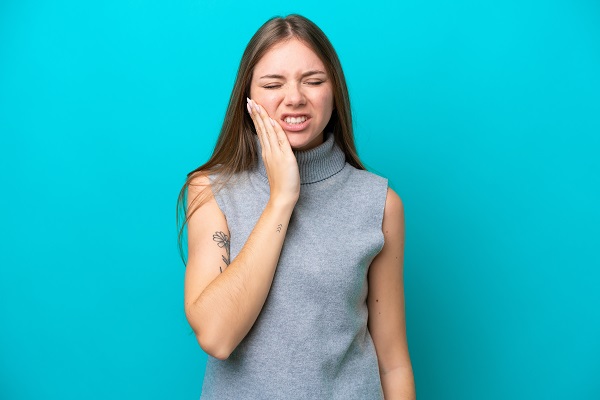Soft-Tissue Laser Dentistry Covina, CA
Laser dentistry allows providers to perform minimally invasive surgeries on the mouth and gums. This technologically advanced dentistry benefits patients and improves outcomes. Soft-tissue laser dentistry is used for surgical procedures involving the oral cavity, gums, and mouth.
Soft-tissue laser dentistry is available at Premier Esthetics Dental Office of Mark R. Gadberry D.D.S., Inc. in Covina and the surrounding area. Our dental practice is committed to using the latest technological tools to improve treatment times and healing. To learn more about our services or schedule an appointment, call us today at (626) 472-2170.
The Pros and Cons of Soft-Tissue Laser Dentistry
Soft-tissue laser dentistry offers many advantages for both patients and providers. Lasers often minimize bleeding and additional swelling after a procedure. They are also more precise than traditional surgical tools, making it easier to provide targeted treatments. Some patients may also experience less pain during a soft-tissue laser procedure versus traditional surgery.
There are also some disadvantages to soft-tissue laser treatments. Procedures with a laser may be more expensive due to the provider's initial cost of the equipment. Additionally, laser therapy is only available for a small number of procedures and not for some common dental treatments, such as removing crowns or filling cavities. It is also imperative that providers follow the recommended practices for laser safety with their staff members.
“Lasers often minimize bleeding and additional swelling after a procedure.”
Soft-Tissue Laser Dentistry in Orthodontics
Laser dentistry is being incorporated more often in orthodontic treatments. Dental providers can use soft-tissue lasers to help contour gums and reshape them to remove excessive gum tissue. Lasers can also be part of a treatment plan for impacted teeth. The laser allows the tooth to grow more appropriately into the mouth, improving the patient's smile.
“Dental providers can use soft-tissue lasers to help contour gums and reshape them to remove excessive gum tissue.”
Post-Treatment Care and Tips
After a soft-tissue laser dentistry treatment, patients must follow the post-op care from Premier Esthetics Dental Office of Mark R. Gadberry D.D.S., Inc.. As stated in Mouth Healthy, it may be necessary to stick to a mild or liquid diet for a few days after the surgery. Then, patients may be asked to transition to a soft food diet for a week or two until the mouth or gums are healed.
The areas treated by the laser may feel tender, so it is normal to experience a little soreness. The surgical site may appear grey, red, purple, or other unusual colors while healing. It may also be necessary to avoid brushing and flossing the surgical spot and use a warm saltwater rinse to clean it instead.
“The areas treated by the laser may feel tender, so it is normal to experience a little soreness.”
Check out what others are saying about our dental services on Yelp: Soft-Tissue Laser Dentistry in Covina, CA
Candidates for Soft-Tissue Laser Dentistry
Soft-tissue laser dentistry may be an option for some treatments. Dental procedures such as gum re-contouring, crown lengthening, and periodontal disease treatments may be performed using a laser. By using a laser during dental treatment, we can increase the precision of the treatment and target specific areas that may be difficult to reach with traditional methods.
Our team will work with you to determine if the patient can benefit from soft-tissue laser treatment. During the consultation, we will review the patient’s medical history and state of oral health to determine if they are a candidate for this procedure.
“Our team will work with you to determine if the patient can benefit from soft-tissue laser treatment.”
Questions Answered on This Page
Q. What are the pros and cons of soft-tissue laser dentistry?
Q. What is the role of soft-tissue laser treatment in orthodontics?
Q. What should I do after my soft-tissue laser dentistry treatment?
Q. Do I need soft-tissue laser dentistry?
Q. What can soft-tissue laser therapy be used for?
People Also Ask
Q. What are the benefits of getting a gum contouring procedure?
Different Types of Soft-Tissue Laser Dentistry
According to WebMD, there are different types of surgeries that use soft-tissue lasers. Before the surgery, your dental provider will explain the steps of your specific procedure. The most common type of laser used in soft-tissue procedures by dental providers is the diode laser. Here are some examples of what may happen during a soft-tissue laser surgery:
- Cutting Tissue: If a provider uses a laser instead of a traditional cutting tool for surgery, it is often more precise. For surgeries such as frenum removal, gum reshaping, and periodontal therapy, the laser cuts through the tissue easily. After cutting, bleeding is minimal and improves healing time.
- Sealing Wounds: Laser therapy can also be used to seal and cauterize surgical cuts. It seals off the blood vessels and capillaries during treatment. This helps reduce swelling after the procedure.
- Eliminating Bacteria: Some soft-tissue laser procedures may involve the eradication of harmful bacteria. In periodontal treatments, the laser acts as a bacteria eliminator and improves the patient’s outcome. The heat generated by the laser and the targeted way it can treat the gums’ diseased pockets removes bacteria that cause periodontal complications.
“The most common type of laser used in soft-tissue procedures by dental providers is the diode laser.”
Frequently Asked Questions
Q. Does soft-tissue laser dentistry hurt?
A. When dental providers use laser therapy during a procedure, it can help reduce pain during and after the surgery. Dental lasers are extremely precise and can seal off the soft tissue's nerve endings, reducing pain. Some patients who have anxiety about dental treatments may also feel more relaxed.
Q. How is laser dentistry used for a frenectomy?
A. The frenum is tissue in the mouth that connects to another part of the mouth. This connective tissue joins the gums to the cheeks, the tongue to the bottom of the mouth, and the lips to the top of the teeth. Individuals who have problems with an elongated frenum may need to get this tissue removed in a procedure called a frenectomy. This is a surgical procedure that can be conducted using soft-tissue laser dentistry.
Q. How long has soft-tissue laser dentistry been around?
A. According to WebMD, laser therapy has been used in dental offices since the 1990s. Over time, the treatment has improved with the advent of more powerful lasers and better techniques. The future of laser dentistry looks even more promising for patients.
Q. How are staff members prepared to perform laser dentistry?
A. To use lasers in a clinical setting, providers undergo many hours of training. They start with training courses in the techniques and earn certifications in the different types of laser equipment. Staff must also be trained in safety standards and procedures when using lasers in a dental setting.
Q. What is a diode in laser dentistry?
A. Many offices use diode lasers for their soft-tissue procedures. Diodes in a laser device are constructed from semiconductor crystals. Using electrical current, the diode in the laser emits a small, focused dot of light. Dental lasers use a fiber optic system to channel the light into surgical uses.
Quality Dental Services Can Transform Your Smile
By visiting us as soon as possible, our team can help get you the professional treatment you need. Instead of waiting around and allowing the symptoms to get worse, we can provide you with treatment options.
Dental Terminology
Contact Us To Learn More
If you are interested in finding out whether you are a candidate for laser treatment, contact us. Call us at 626-472-2170 to schedule a consultation. We are proud to provide our Covina patients with the most effective tools in dental care.
Helpful Related Links
- American Dental Association (ADA). Glossary of Dental Clinical Terms. 2022
- American Academy of Cosmetic Dentistry® (AACD). Home Page. 2022
- WebMD. WebMD’s Oral Care Guide. 2022
About our business, license, and website security
- Premier Esthetics Dental Office of Mark R. Gadberry D.D.S., Inc. was established in 1998.
- We accept the following payment methods: American Express, Cash, Check, Discover, MasterCard, and Visa
- We serve patients from the following counties: Los Angeles County, and San Bernardino County
- We serve patients from the following cities: Covina, Baldwin Park, West Covina, Walnut, San Dimas, and Glendora
- CA (License #37418). View License Information and Specifics
- National Provider Identifier Database (1790883957). View NPI Registry Information
- Norton Safe Web. View Details
- Trend Micro Site Safety Center. View Details
